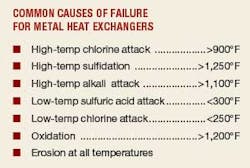Gas-to-gas shell and tube heat exchangers and ceramic materials … none of these is too exciting, but when successfully combined into one product they can significantly improve your process and positively impact your bottom line.
We’re all familiar with heat exchangers; there is at least one in every car. They are more typically referred to as radiators, but in fact they are heat exchangers. While simple and comparatively cheap, radiators get the job done. And if you are lucky, you will never have to drain the nauseously sweet smelling and slimy fluid from one to replace a worn out or damaged radiator.
But, when that same technology is applied to a demanding industrial process, replacing or rebuilding heat exchangers becomes a capital expense that hits your bottom line, time and time again.
Similarly, if you have ever cooked on a pizza stone or changed your own spark plug, you’ve used or at least been exposed to ceramic materials. Now, the ceramics to be described here are different in composition, shape, and application, but of the same category of refractory materials.
Ceramics are used in numerous applications: They allow us to run thermal processes at higher temperatures and in severely corrosive and abrasive environments. They can be great thermal conductors, but also great thermal and electric insulators. Compared to metal, a properly selected ceramic will outperform in any thermal application while reducing or eliminating concerns of corrosion, erosion, oxidation and thermal degradation. Replacing metal components with ceramics can significantly reduce downtime due to material failure, while increasing efficiency and process operating temperatures.
Due to the wide variation in these processes, metals also are very difficult to select. For instance, a metal that has great creep strength at elevated temperatures may be very poor at resisting certain acid attacks. Another metal that has good resistance to acids may not perform in an erosive environment. Often, compromises have to be made for the materials of construction in metal heat exchangers.
By adopting a ceramic heat exchanger you can reduce and sometimes eliminate the common issues that plague metal heat exchangers, issues like: high-temperature alkali attack; high-temperature sulfidation; high-temperature chlorine attack; low-temperature chlorine attack; low-temperature sulfuric acid attack; erosion; and oxidation. By combining the simplicity of a shell and tube heat exchanger with ceramic internal components, we can take advantage of these two well-known technologies to provide a robust and innovative product with zero compromises.
For nearly 50 years, Heat Transfer International has built and operated ceramic heat exchangers for acidic environments, and for operating temperatures up to 2,200°F. It has taken years of commitment, research and development, and a fair amount of frustration to produce a product that can be considered in a class of its own.
There were many highlights in the course of development, including an innovative compensation system that allows for the complex thermal growth of the ceramic materials. After multiple iterations, HTI has developed simple and robust designs for use in applications of various pressure and temperature ranges.
The sourcing and manufacture of the ceramic tubes also was an important part of our development. After working with multiple suppliers, the tubes are now controlled to meet strict specifications, not only in regard to size and shape, but also to material composition and manufacturing process. The result is a tube that has hardness second only to diamond, while maintaining superb thermal conductivity, and resistance to abrasion, corrosion, oxidation and thermal shock. Our search for the optimum tube also exposed us to a variety of different material grades. These various grades of tubes increase the flexibility of the heat exchanger by allowing it the ability to adapt to specific process needs, simply by changing materials.
HTI most commonly uses silicon-carbide tubes. Silicon carbide is the ultimate in hardness, strength at temperature and corrosion resistance, and yet silicon-carbide tubing is surprisingly light, has great thermal conductivity, and can safely and dependably operate at process temps up to 2,500°F. In addition to the various grades of silicon carbide, there are also alumina and mullite tubes. All of these products have an appropriate place in the design of ceramic heat exchangers. How does it all work?
A ceramic heat exchanger is based on common shell and tube heat-exchanger designs. The main difference comes in the application of the ceramic tubes. Many innovative details have been incorporated into the assembly to account for the differences in materials of construction, as compared to metals. The shell itself can be a stamped ASME pressure vessel, designed to operate with a layer of refractory to provide thermal efficiency as well as personnel protection. The baffles and tube sheets are similar in design to traditional components, with the integration of a compensation system. The tubes and connections are where years of research and development have paid dividends.
The heat exchanger as a whole operates like any other shell and tube heat exchanger. The placement of gas streams depends on application, as moisture, particulate, gas composition, and system pressure can influence refractory and tube performance. Each ceramic heat exchanger is sized according to its process to provide the most robust and efficient product.
Will Shepard is the mechanical engineering team leader for Heat Transfer International.

